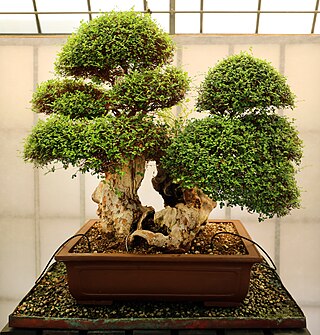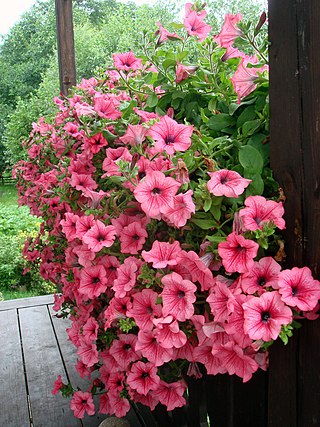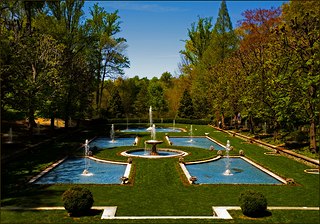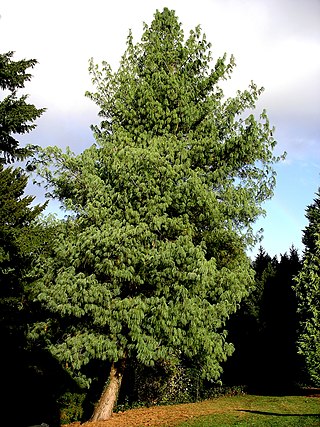
Bonsai is the Japanese and East Asian art of growing and training miniature trees in containers, developed from the traditional Chinese art form of penjing . Penjing and bonsai differ in that the former attempts to display "wilder," more naturalistic scenes, often representing landscapes, including elements such as water, rocks, or figurines; on the other hand, bonsai typically focuses on a single tree or a group of trees of the same species, with a higher level of aesthetic refinement. Similar versions of the art exist in other cultures, including the miniature living landscapes of Vietnamese Hòn non bộ. During the Tang dynasty, when penjing was at its height, the art was first introduced in China.

Horticulture is the cultivation of plants in gardens or greenhouses, as opposed to the field-scale production of crops characteristic of agriculture. It includes the cultivation of fruits, vegetables, nuts, seeds, herbs, sprouts, mushrooms, algae, flowers, seaweeds and non-food crops such as grass and ornamental trees and plants. It also includes plant conservation, landscape restoration, landscape and garden design, construction, and maintenance, and arboriculture, ornamental trees and lawns.

Ornamental plants or garden plants are plants that are primarily grown for their beauty but also for qualities such as scent or how they shape physical space. Many flowering plants and garden varieties tend to be specially bred cultivars that improve on the original species in qualities such as color, shape, scent, and long-lasting blooms. There are many examples of fine ornamental plants that can provide height, privacy, and beauty for any garden. These ornamental perennial plants have seeds that allow them to reproduce. One of the beauties of ornamental grasses is that they are very versatile and low maintenance. Almost all types of plant have ornamental varieties: trees, shrubs, climbers, grasses, succulents, aquatic plants, herbaceous perennials and annual plants. Non-botanical classifications include houseplants, bedding plants, hedges, plants for cut flowers and foliage plants. The cultivation of ornamental plants comes under floriculture and tree nurseries, which is a major branch of horticulture.

Longwood Gardens is a botanical garden that consists of over 1,077 acres of gardens, woodlands, and meadows in Kennett Square, Pennsylvania, United States in the Brandywine Creek Valley. It is one of the premier horticultural display gardens in the United States and is open to visitors year-round to enjoy native and exotic plants and horticulture, events and performances, seasonal and themed attractions, as well as educational lectures, courses, and workshops.

Araucaria heterophylla is a species of conifer. As its vernacular name Norfolk Island pine implies, the tree is endemic to Norfolk Island, an external territory of Australia located in the Pacific Ocean between New Zealand and New Caledonia. It is not a true pine, which belong to the genus Pinus in the family Pinaceae, but instead is a member of the genus Araucaria, in the family Araucariaceae, which also contains the hoop pine. Members of Araucaria occur across the South Pacific, especially concentrated in New Caledonia where 13 closely related and similar-appearing species are found. It is sometimes called a star pine, Polynesian pine, triangle tree or living Christmas tree, due to its symmetrical shape as a sapling.

Pinus wallichiana is a coniferous evergreen tree native to the Himalaya, Karakoram and Hindu Kush mountains, from eastern Afghanistan east across northern Pakistan and north west India to Yunnan in southwest China. It grows in mountain valleys at altitudes of 1800–4300 m, reaching 30–50 m (98–164 ft) in height. It favours a temperate climate with dry winters and wet summers. In Pashto, it is known as Nishtar.
Garden design is the art and process of designing and creating plans for layout and planting of gardens and landscapes. Garden design may be done by the garden owner themselves, or by professionals of varying levels of experience and expertise. Most professional garden designers have some training in horticulture and the principles of design. Some are also landscape architects, a more formal level of training that usually requires an advanced degree and often a state license. Amateur gardeners may also attain a high level of experience from extensive hours working in their own gardens, through casual study, serious study in Master gardener programs, or by joining gardening clubs.

The cottage garden is a distinct style that uses informal design, traditional materials, dense plantings, and a mixture of ornamental and edible plants. English in origin, it depends on grace and charm rather than grandeur and formal structure. Homely and functional gardens connected to cottages go back centuries, but their stylized reinvention occurred in 1870s England, as a reaction to the more structured, rigorously maintained estate gardens with their formal designs and mass plantings of greenhouse annuals.

Grevillea robusta, commonly known as the southern silky oak, silk oak or silky oak, silver oak or Australian silver oak, is a flowering plant in the family Proteaceae. It is a tree, the largest species in its genus but is not closely related to the true oaks, Quercus. It is a native of eastern coastal Australia, growing in riverine, subtropical and dry rainforest environments.

Tree shaping uses living trees and other woody plants as the medium to create structures and art. There are a few different methods used by the various artists to shape their trees, which share a common heritage with other artistic horticultural and agricultural practices, such as pleaching, bonsai, espalier, and topiary, and employing some similar techniques. Most artists use grafting to deliberately induce the inosculation of living trunks, branches, and roots, into artistic designs or functional structures.

Sir Harry James Veitch was an eminent English horticulturist in the nineteenth century, who was the head of the family nursery business, James Veitch & Sons, based in Chelsea, London. He was instrumental in establishing the Chelsea Flower Show, which led to his being knighted for services to horticulture.

Axel Erlandson was a Swedish American farmer who shaped trees as a hobby, and opened a horticultural attraction in 1947 called "The Tree Circus", advertised with the slogan "See the World's Strangest Trees Here".
Living sculpture is any type of sculpture that is created with living, growing grasses, vines, plants or trees. It can be functional and/or ornamental. There are several different types of living sculpture techniques, including topiary, sod works, tree shaping and mowing and crop art. Most living sculpture technique requires horticultural skills, such as grafting or pruning, to create the art.

Richard C. Reames is an American artist, arborsculptor, nurseryman, writer, and public speaker. He lives and works in Williams, Oregon.

Arthur Wiechula was a German landscape engineer. His marriage to Lydia Lindnau, produced three children, Margarethe (1895), Max (1897) and Ernst (1900).
Dan Pearson is an English landscape designer, specialising in naturalistic perennial planting.
Michael O'Connell was an English Modernist artist who worked in Australia between World War I and World War II and then in England. He is best known as a textile artist, with significant works held in the UK in the Victoria and Albert Museum in London, the Museum of English Rural Life in Reading, and the collection of National Museums Scotland, and in Australia in the National Gallery of Australia in Canberra and in the National Gallery of Victoria in Melbourne.
Max Lamb is a British furniture designer who combines traditional, often primitive, design methods with digital design. He is known for employing unusual approaches to using natural materials, including pouring pewter onto sand, and volcanic rock.
Full Grown is a UK company that grows trees into chairs, sculptures, lamps, mirror frames and tables. It was co-founded by Gavin Munro in 2005.
There are various methods of tree shaping. There are strengths and weaknesses to each method as well commendable tree species for each process. Some of these processes are still experimental, whereas others are still in the research stage. These methods use a variety of horticultural and arboricultural techniques to achieve an intended design. Chairs, tables, living spaces and art may be shaped from growing trees. Some techniques used are unique to a particular practice, whereas other techniques are common to all, though the implementation may be for different reasons. These methods usually start with an idea of the intended outcome. Some practitioners start with detailed drawings or designs. Other artists start with what the tree already has. Each method has various levels of involvement from the tree shaper.















